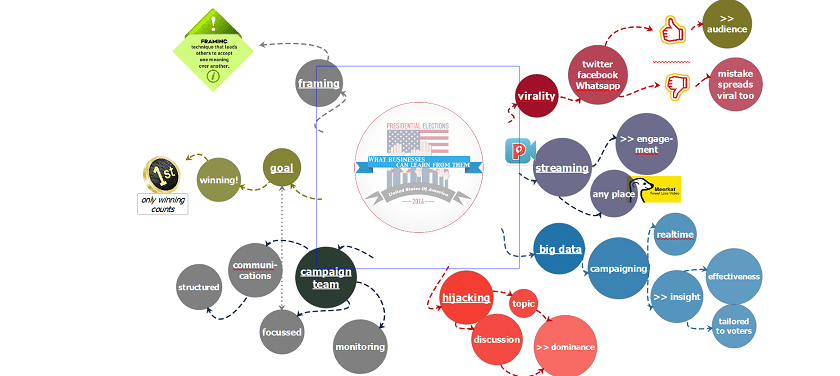Many companies may think there is little to learn from political campaigns. However, there are quite a few things that politicians are really good at. Indeed, there are a lot of marketing lessons businesses (certainly smaller ones) can learn from campaigning and politicians.
Perhaps one crucial aspect of campaigning is that it is highly results-oriented (getting votes) and all about winning (e.g. being nominated to run for president). Business owners can copy that by directing prospects to take a specific action whenever they do any marketing or advertising.
The key feature of e.g. presidential campaigns ‘only winning counts’ is reflected in the way the campaign team works. It is focused, the communication is extremely structured. And let me tell you, having worked at dozens of companies and organizations, communications are very often not that structured. Sometimes it’s not structured at all.
Another interesting thing is the way politicians get their message across through the use of framing. Framing is a quality of communication that leads others to accept one meaning over another. Research conducted at Twente University shows that the way an issue is framed has a significant impact on both perceptions of the issue and acceptance of the message. A good example is the framing of the nuclear agreement with Iran. The Obama administration’s frame: “it’s this deal or war”. The concept of framing is 100% applicable in marketing brands. A good example of framing is the marketing of the iPod as a fashion accessory rather than an mp3 player. Well, it paid off. Apple sold nearly 400 million iPods, cashing some $68 billion.
Another peculiarity of campaigners is that they are early adopters. Obama announced his victory in 2008 with a tweet that was only retweeted 157 times. The 2012 one though, was retweeted more than 800,000 times – as stated in the study on The presidential campaigns’ use of Twitter during the 2012 electoral cycle. Social media is an ever-evolving component of modern presidential campaigns. Besides many aspects like agenda setting, it is very much about scope. Hillary Clinton announced her presidential exploratory committee with a YouTube video in 2007, saying while she couldn’t “visit everyone’s living room, I can try.” As the 2012 elections were about Twitter, 2016 is going to be about streaming video. You don’t need an expensive satellite truck and satellite time to broadcast an event or message. Consider this. Suppose you are a company making technical products. Why would you exhibit at a trade show at high costs (and not to forget the hidden costs), when you can live stream your product to a much larger audience?
Well, please navigate through the mind map and let me know what you think in the comments below.
About the author
Hans Buskes is a business consultant, marketing communications manager, and mind mapper. He’s author of several mind map books and mind map blogger on Mastermindmaps.




